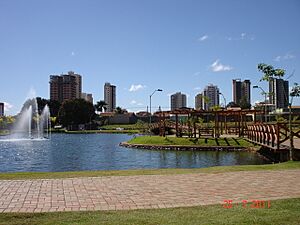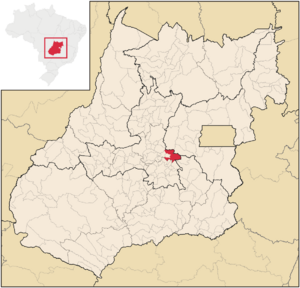Anápolis facts for kids
Quick facts for kids
Anápolis, Goiás
|
|||
|---|---|---|---|
|
Municipality
|
|||
| Município de Anápolis Municipality of Anápolis |
|||

View of Ipiranga Environmental Park (Parque Estacionamento Ipiranga)
|
|||
|
|||
| Nickname(s):
"Manchester of Goiás"
|
|||
 |
|||
| Country | |||
| Region | Central-West | ||
| State | |||
| Settled | 18th century | ||
| Incorporated as a town | December 15, 1887 | ||
| Incorporated as a city | July 31, 1907 | ||
| Area | |||
| • Total | 918.375 km2 (354.587 sq mi) | ||
| Elevation | 1,017 m (3,337 ft) | ||
| Population
(2022)
|
|||
| • Total | 398,869 | ||
| • Density | 434.3204/km2 (1,124.8847/sq mi) | ||
| Demonym(s) | Anapolino | ||
| Time zone | UTC-3 (UTC-3) | ||
| • Summer (DST) | UTC-2 (BRST) | ||
| Postal code |
75000-000
|
||
| Area code(s) | +55 62 | ||
| Website | www.anapolis.go.gov.br | ||
Anápolis is a Brazilian city in the state of Goiás. It's special because it sits right between two important capitals: Brasília, the country's capital, and Goiânia, the capital of Goiás. Anápolis is the third-largest city in Goiás, with almost 400,000 people living there in 2022.
It's a big hub for industries and moving goods around in the central-west part of Brazil. The city's economy is very strong, making it one of the richest in the state. It became an industrial powerhouse after its Industrial District was built in 1970.
Contents
What's in a Name?
The name Anápolis comes from two parts: "Ana" and "polis." "Ana" is a name, and "polis" means "city" in Greek. So, Anápolis means "city of Ana."
A Look Back in Time
The story of Anápolis began in the 1700s. People called drovers, who moved cattle, often traveled through this area on their way to gold mines nearby. Some of these travelers, when they couldn't find gold anymore, decided to settle down.
The first time this area was written about was in 1819. A French traveler named Auguste de Saint-Hillaire visited a place called Tapirs' Farm. It was named this because there were many tapirs (a type of animal) in the region.
The first official document about the settlement was written on April 25, 1870. A group of people living there gave some of their land to build a place for Our Lady of Saint Anne.
The Legend of Saint Anne
There's a local story from 1859 about a woman named Ana das Dores. She was traveling with mules, and one mule carrying a statue of Saint Anne got lost. When it was found, the mule refused to move. Ana believed this meant Saint Anne wanted to stay there. She promised to build a chapel for the Saint, and then the mule started moving again.
Her son, Gomes de Souza Ramos, built the chapel eleven years later. In 1872, people asked for the settlement to become a parish (a small church district). This wish was granted on August 6, 1873.
Becoming a City
On February 28, 1882, José da Silva Batista moved to the area. He and Souza Ramos wanted the settlement to become an official town. This was approved on December 15, 1887. However, it didn't fully become a town until March 10, 1892. That's when Batista became the head of the town's administration. The town officially became a city on July 31, 1907.
Anápolis was the first city in Goiás to get electricity, which happened on January 9, 1924. The telegraph arrived in 1926, and a railroad reached the city in 1935.
Where is Anápolis?
Anápolis is in the central-western part of Brazil. It sits on a high flat area called the Central Plateau, about 1,017 meters (3,337 feet) above sea level. The city covers an area of about 918 square kilometers (354 square miles). It shares borders with several other towns like Abadiânia and Pirenópolis. Anápolis is also the main city of its local region.
What's the Weather Like?
| Weather chart for Anápolis | |||||||||||||||||||||||||||||||||||||||||||||||
|---|---|---|---|---|---|---|---|---|---|---|---|---|---|---|---|---|---|---|---|---|---|---|---|---|---|---|---|---|---|---|---|---|---|---|---|---|---|---|---|---|---|---|---|---|---|---|---|
| J | F | M | A | M | J | J | A | S | O | N | D | ||||||||||||||||||||||||||||||||||||
|
281
27
19
|
166
28
19
|
263
28
20
|
115
28
19
|
42
28
18
|
6
27
16
|
14
27
15
|
48
28
17
|
48
29
18
|
125
28
19
|
154
27
19
|
205
28
19
|
||||||||||||||||||||||||||||||||||||
| temperatures in °C precipitation totals in mm |
|||||||||||||||||||||||||||||||||||||||||||||||
|
Imperial conversion
|
|||||||||||||||||||||||||||||||||||||||||||||||
Anápolis has a tropical savanna climate. This means it has dry, cool winters and hot, rainy summers. In July, the average low temperature is around 14°C (57°F), and there's very little rain.
The hottest months are August and September, with average high temperatures reaching about 29°C (84°F). During the summer, it rains a lot, with about 280 millimeters (11 inches) of rain in January.
Getting Around
Anápolis is a key spot for transportation. It's on the main highway (BR 060) that connects Brasília and Goiânia, which is now a four-lane road. It's also where the famous Belém-Brasília highway (BR 153) begins.
- Distance to Goiânia: 54 km (34 miles)
- Distance to Brasília: 140 km (87 miles)
- Distance to São Paulo: 872 km (542 miles)
The city also has a railroad that connects to important ports in Brazil. Anápolis will be the starting point for a new north-south railroad, which will link it to the Port of Itaqui in Maranhão and other key places in the North and Northeast of Brazil. There are also plans for a train service called Expresso Pequi to connect Brasília and Goiânia, with a stop in Anápolis.
Anápolis has a city airport, which is being improved to handle more cargo (goods being shipped).
Economy: How Anápolis Makes Money
Anápolis is one of the most developed cities in its state. It has a fast-growing industrial area with many factories, especially for medicines. Getting around is easy because of good highways connecting it to Goiânia and Brasília.
The city has many educated people because of its universities and colleges. The land around Anápolis is great for growing fruits like oranges, bananas, and sugarcane. All these things make Anápolis a very strong economic city, second only to the state capital.
Economic Facts
- In 2008, the city's Gross Domestic Product (GDP) was about 6.265 billion Brazilian Reais. This was the second largest in the state and the seventh largest in Brazil.
- The average GDP per person in Anápolis in 2008 was 18,910 Reais, which was higher than the state average.
Hyundai has a factory in Anápolis that makes cars like the Hyundai Tucson and Hyundai HB20.
Farming and Industry
Historically, Anápolis has been known for its rich farming areas. Raising animals has always been a big part of the local economy. In 2003, the city had:
- 65,000 beef cattle
- 8,000 pigs
- 138,000 poultry (chickens, etc.)
- 9,500 dairy cattle
Farmers also grow many crops:
- Rice: 160 tons
- Corn: 7,200 tons
- Soybeans: 4,590 tons
- Tomatoes: 2,250 tons
- Bananas: 8,300 tons
The DAIA (Distrito Agro-Industrial de Anapolis) is the main industrial area. It includes big companies like Laboratório Teuto Brasil, which is the largest factory in Brazil producing generic medicines. The government decided to build a major logistics center around DAIA. This makes Anápolis a key place for distributing goods across Brazil by road, rail, and air.
In 2003, many people worked in different areas:
- Manufacturing (factories): 12,980 workers
- Stores and shops: 18,114 workers
- Transportation: 3,880 workers
- Public services (government, defense): 6,724 workers
- Education: 3,723 workers
- Health: 2,247 workers
In 2004, there were 23 banks and financial places in the city.
Vehicles in Anápolis
As of May 2011, Anápolis had many vehicles:
- Cars: 90,332
- Trucks: 9,151
- Pickup trucks: 13,542
- Motorcycles: 39,044
Air Force Base
Anápolis Air Force Base - ALA2 is one of the most important bases for the Brazilian Air Force. It helps protect the nearby capital city of Brasília. It's also a key part of the Amazon Surveillance System (SIVAM), which monitors the Amazon rainforest.
How Anápolis Ranks in Human Development
The Human Development Index (MHDI) measures how well people are living in a place. It looks at things like how long people live, how many adults can read, and how many children go to school.
Here's how Anápolis ranked in 2000:
- Life expectancy (how long people are expected to live): 70.2 years
- Adult literacy rate (how many adults can read): 91.2%
- School attendance rate (how many children go to school): 84.4%
- Overall MHDI score: 0.788 (higher is better)
- State ranking: 16th out of 242 cities in Goiás
- National ranking: 851st out of 5,507 cities in Brazil
Famous People from Anápolis
- Luciano (Football player)
- Derley (Football player)
- Henrique Meirelles (Politician)
- Felipe Guimarães (Racing driver)
- Paulo Bertran (Economist and historian)
See also
 In Spanish: Anápolis para niños
In Spanish: Anápolis para niños




